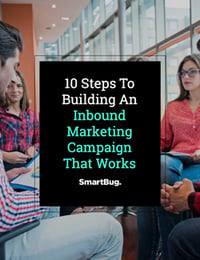
Build an SMS Campaign from the Ground Up to Fuel Your Inbound Strategy
February 3, 2022
If you want to successfully promote your business or product, there’s really no reason you shouldn’t be engaging your audience through an SMS campaign.
Why? Consider where your phone is at this very moment. If it’s on your person or anywhere near you, that’s why. Audiences can be engaged much more easily and consistently through mobile devices over laptops or stationary computers.
Similar to an email campaign, SMS (short message service) campaigns send text messages to a large list of subscribers. It’s a low-cost, high-return marketing system that allows you to convey content that makes an offer on a product or redirects the user to a piece of useful content. Plus, it’s a highly personal channel, which means you have an opportunity to engage with an audience in a fun and conversational way.
If you’ve been wondering about the impact of an SMS campaign, how to implement one, and tips on writing engaging text messages, this blog post is for you. Let’s dive in.
The Importance of SMS Campaigns
Did you know that 95 percent of text messages are read and responded to within three minutes of being received? In a world as fast-paced as ours, it’s important that you are reaching an audience where you know you can, such as in the palm of their hands.
There are two main pieces of an SMS marketing strategy:
- Campaign: This is a manually built strategy that sends text messages to a list at a specific time.
- Automation: This is a behavior-based message that is triggered after a purchase, sign-up, or abandoned cart.
Automated messages are a great way to nurture the customer after a purchase or to re-engage the customer if they have selected products but decided against purchasing them.
Campaigns are an excellent way to drive additional sales. Typically, they take place before a holiday. However, campaigns don’t have to be married to a specific time of year. For example, maybe you have a flash sale or a new product launch. A campaign is a great way to blast a list of contacts.
SMS in the Context of an Inbound Strategy
SMS is the shortest contact point in your inbound strategy. It doesn’t intend to educate the reader in the way that blog posts or infographics do, and text messages don’t get lost in the clutter like emails can.
Instead, the text message attempts to capture attention and send the user elsewhere. For example, a really intriguing image-based text message can gain the user’s attention and send them to a product or a piece of downloadable content.
SMS is also incredibly useful for different types of audiences compared to other inbound strategies. For example:
- Existing customers, who are committed to the brand, are more likely to take advantage of a discount or new product.
- Small subsets of any audience prefer SMS interactions over email or other channels.
- Younger generations, such as Gen Z and millennials who have the highest number of mobile device users compared to any other generation, prefer marketing through text messaging.
Ultimately, SMS is nearly guaranteed to be seen by your target audience, and it continues to grow in sales conversion rates.
Ready to learn how our e-comm marketers can help you? Get in touch!
Step-by-Step Guide to Kicking Off an SMS Campaign
Before you can start sending out text messages, you’ll need to develop strategies on two fronts: collecting phone numbers and planning campaigns.
Collect phone numbers with these four strategies.
Without being too obvious, if you don’t have phone numbers, you don’t have an SMS campaign. That being said, many people are hesitant to give out their phone numbers, so your collection strategies need to be discreet.
Here are four scenarios where users would have the opportunity to provide their phone number:
- Pop-up on a website after an email address is collected
- During checkout in the personal information section
- Through email campaigns or automations that provide incentives for users to sign up for SMS
- On landing pages from inbound campaigns
Create a campaign calendar and decide on messaging.
A successful SMS campaign is one that is well-researched and organized around important dates. When planning, consider your product:
- Is it important to promote before the holidays?
- Is it a product that commonly has flash sales, such as apparel?
- Would it help to have an additional piece of content, such as a blog post or guide, to nurture the audience?
- Do you have a product release that needs to be promoted?
Once you have decided on the important dates to promote your product, you want to consider the types of messages you are going to send. For example:
- If you sell fitness or health products, a message sent out at the beginning of a new year might offer some motivational messaging that also includes a discounted rate on the product.
- If you are an apparel company, you will want to spend the month of November promoting the discounts on clothing leading up to Black Friday.
- Or, if your product is seasonal, you will want to promote content to the audience to build up excitement before the big sales event.
Regardless of the type of messaging, a successful campaign is measured by nailing down the date and time of day that the message is sent out based on preliminary research on your demographics.
Keep in mind that SMS messages can also encourage a response to the message if the customer needs to get routed to customer support for quick interactions to increase conversions.
Tips for Creating Engaging SMS Content
Now, on to the fun stuff: creating content for the campaign. Much like headlines for a blog or video, an SMS message needs to capture attention, spark interest, and get someone to click with a single text message, which has a maximum of 160 characters.
1. Showcase your brand’s personality.
Ultimately, the tone of your messages need to match your brand. Would it work for them to be funny and witty? Or more educational and stoic? Regardless of tone, it’s important that you’re able to showcase your brand’s personality.
2. Avoid toggling.
One way to not showcase personality is by simply turning on toggles and offering discounts. Of course, you want these messages to convert into sales, but this doesn’t happen if the audience is not intrigued.
3. Create rich content.
Unlike other forms of written marketing content, text messages offer the opportunity to use visuals as a way to delight. Many marketers use gifs, photos, and videos to add another layer of entertainment and information to the message.
4. Keep it quick and directed.
Remember, you’re competing with all the apps and activities of a smartphone when you send a text message, which means your user needs to read your message quickly and know exactly what actions should be taken.
Build a Well-Rounded Inbound Marketing Campaign
We hope this has been helpful as you consider implementing an SMS campaign into your marketing strategy. However, SMS is just one piece of the inbound marketing puzzle.
To learn more about the many benefits of an inbound marketing campaign, contact one of our e-comm marketers today!

About the author
Ryan O’Connor was formerly SmartBug’s Director of E-commerce Growth, product manager, and sales director. He enjoys helping readers learn how to solve big business challenges through consumer psychology within the constantly evolving e-commerce landscape. Over the past 10 years, Ryan has helped 1000s of DTC brands navigate challenges to grow fast through intelligent marketing. He’s not afraid to get his hands dirty, having launched his own e-commerce stores from the ground up. Read more articles by Ryan O’Connor.








